One of the five marvelous museums that sit on Berlin’s Museum Island, the Pergamon Museum is the newest and most popular. The museum is named after the Pergamon Altar, an enormous monument that occupies a whole room.
The museum is closed for a long-term renovation project and will partially reopen in 2027. The southern wing is expected to reopen ten years later, in 2037.
History of the Museum
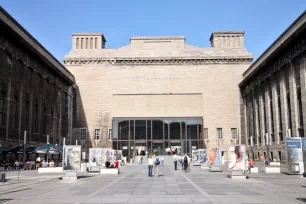
Designed by Alfred Messel, and later Ludwig Hoffmann, the Pergamon Museum was built to complement the nearby Kaiser-Wilhelm Museum (now the Bode Museum), which had grown too small to house the artifacts garnered from German excavations throughout the world.
The idea for the new museum came about in 1907 and completion took twenty years – from 1910 to 1930. The monumental building consisted of three wings arranged around a courtyard that opened up towards Kupfergraben, a canal. The museum opened during one of Germany’s most turbulent periods and was subsequently largely destroyed in the bombing of Berlin during World War II.
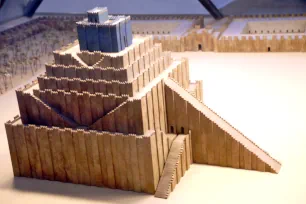
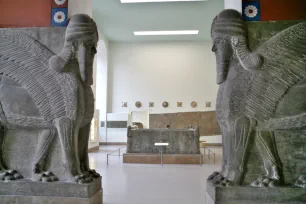
Fortunately, many of the pieces had been stored elsewhere for safe keeping and a number of the museum’s larger pieces were “walled in” for protection. In 1945, a portion of the original collection was taken to Russia and is still housed in the Hermitage and the Pushkin Museums there. Many items were returned in the late 1950s but, due to Russian restitution laws, some still remain in those two museums.
In 2012 an ambitious renovation project was initiated that will integrate the museum more closely with the other museums on Museum Island. The project also includes the construction of a fourth wing that will house monumental architecture from Egypt. The project is expected to be completed in 2025.
The Collections
The Pergamon Museum owns an impressive collection of objects that were excavated by German archaeologists in the nineteenth and early twentieth century in Egypt, the Near East, Greece, and Rome. The backbone of the museum is formed by its monumental architectural pieces that will impress even the most experienced museum visitor.
The Pergamon Altar
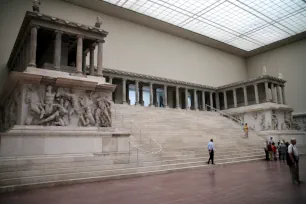
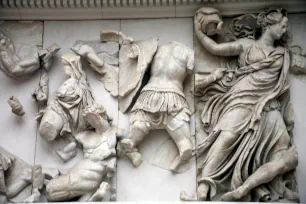
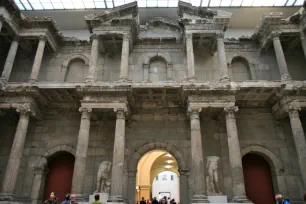
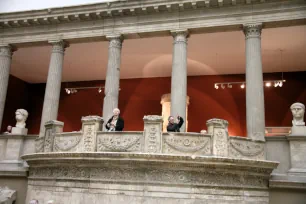
The centerpiece of the museum is the Pergamon Altar (180-160 B.C.), which is so huge that it requires an entire room. Constructed in Pergamon, Asia Minor, as an altar to Zeus, the gigantic structure was unearthed in 1876 by the archaeologist Carl Humann and brought to Berlin in 1903. The massive marble altar was located on the acropolis of the ancient Greek city of Pergamon (now in Turkey).
The monument was adorned with an enormous, 113 meter (370ft) long frieze that wrapped around the altar and depicted a battle between the gods and giants. The marble frieze was originally painted and gilded. It is considered one of the finest examples of Hellenistic sculpture. Parts of this frieze have been reconstructed and can be seen on the walls of the museum’s main hall. A staircase leads to a colonnade that is decorated with another frieze that depicts events from the life of Telephos, the mythical founder of Pergamon.
Market Gate of Milete
Another huge monument in the Pergamon Museum is the magnificent Roman gate which led to the market of Miletus, also in Asia Minor. The gate was built in the second century AD in the style of a theatre facade with three archways. It measures 29 meters wide and 17 meters high (95 x 56 ft). In the Middle Ages the gate was damaged by an earthquake, but it was pieced together in the nineteenth century by German archaeologists. The two statues in front of the gate depict a Roman general with a captured barbarian at his feet and a nude hero with a cornucopia.
Opposite the Market gate of Miletus is a reconstructed portico of the Temple of Trajan from Pergamon. This 18-meter-tall marble temple was built between AD 113 and AD 128. It stood at a prominent location near the top of the acropolis of Pergamon and featured slender Corinthian columns.
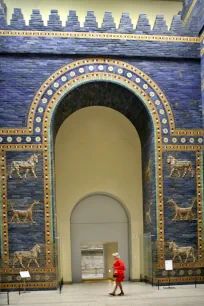
Ishtar Gate
Yet another extraordinary exhibit is the Ishtar Gate and the Processional Street of Babylon, built under King Nebuchadnezzar II (605—562 BC) in what is now the Near East. The gate is decorated with blue-enameled tiles and animal reliefs.
The processional street, which was 250 meters long, is also decorated with enameled tiles and animal figures, which portrayed Babylonian gods. Most of the tiles and reliefs are original. The gate at the end of the processional street, however, is a reconstruction. It gave entrance to the temple of the Babylonian god Marduk, the patron deity of the city of Babylon.
Kalabsha Gate and the Sahu-Rê Temple
The fourth wing of the Pergamon Museum will house monumental Egyptian architecture, including the Kalabsha Gate and the courtyard of the Sahu-Rê temple. The Kalabsha Gate will from the monumental entrance to the Egyptian wing of the museum.
The Gate of Kalabsha is an ancient gate from the Temple of Kalabsha, the largest freestanding temple in Egyptian Nubia. It was built around 30BC, during the reign of the Roman Emperor Augustus. In the 1960s the construction of the Aswan Dam threatened to flood the temple, but with help of the German government it was cut into pieces and relocated. Out of gratitude, the Egyptian government donated the old gate to Germany.
The large columns from the courtyard of King Sahu-Rê’s temple, built around 2400 BC, will also be housed in the new wing of the Pergamon Museum.
More exhibits
Besides these large-scale monuments, there are many more objects on display in the museum, including mosaics, reliefs and statues from the antiquity. The main collection of Roman and Greek antiquities however is based in the Altes Museum, while the main collection of Egyptian antiquities can be seen in the Neues Museum.
The museum is closed for a long-term renovation project and will partially reopen in 2027. The southern wing is expected to reopen ten years later, in 2037.

